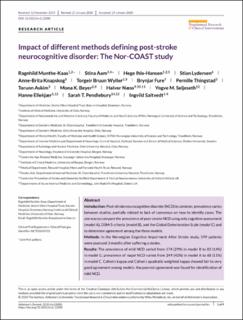| dc.contributor.author | Munthe-Kaas, Ragnhild | |
| dc.contributor.author | Aam, Stina | |
| dc.contributor.author | Ihle-Hansen, Hege | |
| dc.contributor.author | Lydersen, Stian | |
| dc.contributor.author | Knapskog, Anne Brita | |
| dc.contributor.author | Wyller, Torgeir Bruun | |
| dc.contributor.author | Fure, Brynjar | |
| dc.contributor.author | Thingstad, Pernille | |
| dc.contributor.author | Askim, Torunn | |
| dc.contributor.author | Beyer, Mona K. | |
| dc.contributor.author | Næss, Halvor | |
| dc.contributor.author | Seljeseth, Yngve Müller | |
| dc.contributor.author | Ellekjær, Hanne | |
| dc.contributor.author | Pendlebury, Sarah T. | |
| dc.contributor.author | Saltvedt, Ingvild | |
| dc.date.accessioned | 2021-01-22T08:12:13Z | |
| dc.date.available | 2021-01-22T08:12:13Z | |
| dc.date.created | 2020-12-01T07:59:52Z | |
| dc.date.issued | 2020 | |
| dc.identifier.citation | Alzheimer's and Dementia: Translational Research and Clinical Interventions. 2020, 6:e12000 (1), 1-9. | en_US |
| dc.identifier.issn | 2352-8737 | |
| dc.identifier.uri | https://hdl.handle.net/11250/2724210 | |
| dc.description.abstract | Introduction
Post‐stroke neurocognitive disorder (NCD) is common; prevalence varies between studies, partially related to lack of consensus on how to identify cases. The aim was to compare the prevalence of post‐stroke NCD using only cognitive assessment (model A), DSM‐5 criteria (model B), and the Global Deterioration Scale (model C) and to determine agreement among the three models.
Methods
In the Norwegian Cognitive Impairment After Stroke study, 599 patients were assessed 3 months after suffering a stroke.
Results
The prevalence of mild NCD varied from 174 (29%) in model B to 83 (14%) in model C; prevalence of major NCD varied from 249 (42%) in model A to 68 (11%) in model C. Cohen's kappa and Cohen's quadratic weighted kappa showed fair to very good agreement among models; the poorest agreement was found for identification of mild NCD.
Discussion
The findings indicate a need for international harmonization to classify post‐stroke NCD. | en_US |
| dc.language.iso | eng | en_US |
| dc.publisher | Wiley Open Access | en_US |
| dc.rights | Attribution-NonCommercial-NoDerivatives 4.0 Internasjonal | * |
| dc.rights.uri | http://creativecommons.org/licenses/by-nc-nd/4.0/deed.no | * |
| dc.title | Impact of different methods defining post-stroke neurocognitive disorder: The Nor-COAST study | en_US |
| dc.type | Peer reviewed | en_US |
| dc.type | Journal article | en_US |
| dc.description.version | publishedVersion | en_US |
| dc.source.pagenumber | 1-9 | en_US |
| dc.source.volume | 6:e12000 | en_US |
| dc.source.journal | Alzheimer's and Dementia: Translational Research and Clinical Interventions | en_US |
| dc.source.issue | 1 | en_US |
| dc.identifier.doi | 10.1002/trc2.12000 | |
| dc.identifier.cristin | 1854574 | |
| dc.description.localcode | © 2020 The Authors. Alzheimer's & Dementia: Translational Research & Clinical Interventions published by Wiley Periodicals, Inc. on behalf of Alzheimer's Association. This is an open access article under the terms of the Creative Commons Attribution‐NonCommercial‐NoDerivs License, which permits use and distribution in any medium, provided the original work is properly cited, the use is non‐commercial and no modifications or adaptations are made. | en_US |
| cristin.ispublished | true | |
| cristin.fulltext | original | |
| cristin.qualitycode | 1 | |

